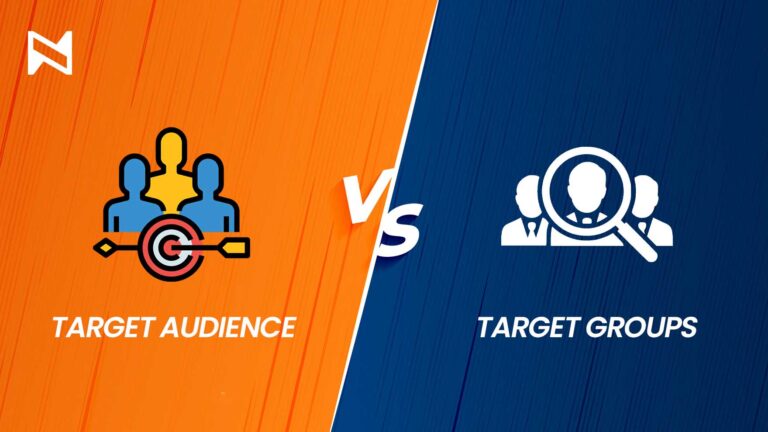Are you struggling to effectively reach your desired audience with your marketing campaigns? As a marketer or advertiser, you may have come across the terms “target audience” and “target group” in your efforts to connect with potential customers. While these terms are often used interchangeably, it’s important to understand the differences between them in order to craft a successful marketing strategy. In this blog post, we will dive into the distinctions between target audience and target group, and why this knowledge is crucial for any marketer looking to achieve their goals.
What Is The Target Audience?
The complete set of individuals your brand determines to be the ones most likely to need or desire the solution your business provides is your target audience.
Your target audience is essentially everyone you want to communicate with about your brand to in order to get as many new clients as you can.
The individuals that make up a target audience are not all the same and are not a two-dimensional group.
The individuals that make up the target audience are more varied the larger it is.
In actuality, your audience may consist of a wide variety of “types” that may be divided into more granular categories.
Factors to consider when defining a target audience:
Demographic information:
Demographic information is used to segment a population into groups that share similar characteristics, such as age, gender, income, education, and geographic location. By gathering data on these demographic factors, marketers can define a specific target audience that is more likely to be interested in their product or service. For example, a company selling baby products might target their marketing efforts toward women aged 25-40 who have recently become new mothers.
Psychographic information:
Psychographic information involves understanding the values, attitudes, beliefs, and lifestyle factors that drive consumer behavior. This information can help marketers to create more targeted and effective marketing messages. For example, a clothing brand targeting eco-conscious consumers might focus on messaging around sustainability and ethical sourcing.
Behavioral information:
Behavioral information is gathered from a customer’s past actions, such as browsing history or purchase behavior. This data can help to predict future behavior and tailor marketing messages accordingly. For example, an online retailer might use data on a customer’s past purchases to recommend similar products that the customer is likely to be interested in.
Examples of how to define a target audience:
Market research surveys:
Market research surveys can be used to gather demographic and psychographic information about a target audience. Surveys can be conducted online or in person and can provide valuable insights into consumer preferences and behaviors.
Social media analytics:
Social media platforms like Facebook and Twitter provide analytics tools that can help to understand the behaviors and interests of a target audience. These platforms offer demographic data and engagement metrics that can inform a brand’s social media strategy.
Customer data analysis:
Analyzing customer data can help to identify patterns and trends that can inform the definition of a target audience. By analyzing purchase history and browsing behavior, marketers can understand the needs and preferences of their customers and create targeted campaigns to drive sales.
Persona creation:
Marketers can create fictional personas that represent their ideal target audience based on demographic, psychographic, and behavioral information. These personas can help to create a more targeted and effective marketing strategy. For example, a company selling athletic gear might create a persona called “Active Annie”, who is a 30-year-old woman who enjoys running and yoga. By targeting marketing messages towards this persona, the company can more effectively reach its desired audience.
What is a Target Group?
One of these more focused subgroups of your target audience is known as a target group.
They pinpoint more narrowly focused and distinct subgroups within the larger target audience, which may include a sizable number of individuals.
Compared to the wider target audience, these groups of individuals are more defined, allowing for more precise marketing.
These groups may be targeted in more precise ways since they are more similar to one another than the general audience in terms of the issues and difficulties they experience.
Although a more generalized brand message aimed at the wider target audience will probably connect with each of the various target groups, a more specific message addressed at each group allows for far deeper brand resonance.
Examples of Brands that understood the differences
Nike’s “Dream Crazier” campaign:
Nike’s “Dream Crazier” campaign was targeted toward women who are tired of being told what they can and cannot do. The campaign featured powerful messaging that celebrated the achievements of female athletes who had broken barriers and challenged the status quo. The campaign resonated with its target audience and led to increased sales and brand loyalty.
Old Spice’s “The Man Your Man Could Smell Like” campaign:
Old Spice’s “The Man Your Man Could Smell Like” campaign was targeted toward women who buy personal care products for men. The campaign featured a humorous and charismatic spokesperson who highlighted the benefits of using Old Spice products. The campaign was a huge success and helped to revitalize the Old Spice brand.
Things to keep in mind when defining a Target audience
The demographics of Your Target Audience Are Insufficient
While your target audience is the largest group of individuals who are specifically targeted by your brand, it shouldn’t be so big that your brand message doesn’t resonate with them.
The first place to go when determining your target audience is their demographics.
In essence, demographics are a collection of classification methods that weed out those who are not part of your target population.
Your target audience is everyone before you even define them.
Secondly, by using data from demographics like Age, Gender, Marital Status, Personal Income, Household Income, and Occupation.
You choose a sizable population from the “everyone” category, excluding those that your business does not want to target or who are least likely to need or desire the services of your brand.
But this is insufficient. Demographics alone won’t cut it since a large section of this demographically based population still doesn’t need or desire your answer.
Psychographics are more Important When Determining Your Audience
In order to take the demographically filtered group of individuals to the next level, psychographics must be used.
Psychographics offer an additional level of classification via behaviors, whereas demographics exclude individuals based on their circumstances.
You may further define your target audience and the group of individuals most likely to require or desire your services by outlining how your audience conducts their life and excluding those who don’t fit into that category.
such actions as
musical tastes
Food Preferences for Sports
Pastimes
Books, News, Magazines, and Publications
Choice Vehicle
Weekend pursuits
You may more successfully target your brand communication and marketing to your target audience by using all of these psychographics to construct a more complete picture of who they are.
Emotion Is Important in Your Target Audience Strategy
You’re left with a set of individuals who are starting to reflect your core target audience after applying demographic and psychographic filters to your target audience. But this particular set of folks is still a work in progress. More information is needed, which will influence how your brand interacts with individuals, including:
Messaging Technique Storytelling Method
Brand Character
Personas
Voice Tone and Brand Language
Your idea of the audience is shaped by the detail needed from this point on. While identifying the group of individuals, demographics and psychographics provide relatively little about:
Their identity
The issues they deal with, the difficulties they encounter, and the aspirations they have
The worries they harbor
The psychological link to these problems
You can only start to plot a strategy to connect with your audience if you start to comprehend these crucial elements that form the “Who” behind them.
What All Target Audience Analysis Shows
Finding out who your audience is, requires some hands-on, roll-up-your-sleeves labor.
You won’t have to search very far to discover them since they are out there.
They are online, posting, participating, and sharing and they are also leaving trails, hints, and insights for you to find.
You may identify organizations and congregations you can join by using the group of individuals you’ve identified, their circumstances, and how they spend their time.
You may discover your audience’s emotions here.
They won’t, of course, be posting their private thoughts for everyone to see, but they will undoubtedly provide insights into their difficulties and hardships, which connect to the feelings they have about them.
Effective target audience analysis requires some research, but if you want to create a brand that connects with people, here is where they are born.
Final Words on Target Audience vs Target Groups
You are undoubtedly in the development stage of creating a brand if you are attempting to differentiate between your target group and target audience.
To select an audience with the appropriate amount of detail, insights, and emotion, it’s critical that you have a solid understanding of the various target audiences, markets, groups, and segments.
How are you doing? Do you have a favorite method for determining your target demographic or audience?
What is your biggest obstacle in terms of identifying your target audience, and is there anything preventing you from moving forward?
Please let me know immediately in the comments!






![What Does A Brand Manager Do [Guide to becoming a brand manager]](https://naumandigital.com/wp-content/uploads/2023/02/14-600x400.jpg)


![The Ultimate Guide of telling a Compelling Brand Story [With Examples]](https://naumandigital.com/wp-content/uploads/2023/02/4-600x400.jpg)